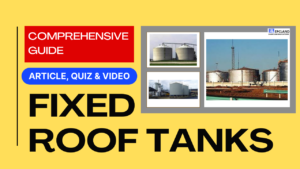Introduction:
Flame arrestors play a pivotal role in maintaining safety in various industrial processes involving piping systems. These ingenious devices are designed to prevent the propagation of flames, sparks, and explosions along pipelines, effectively minimizing the risks of fires and protecting personnel and equipment. In this comprehensive guide, we will delve into the world of flame arrestors in piping engineering, exploring their types, applications, working principles, and installation procedures. Check out the ASME b31.3 here.
Table of Contents
Flame Arrestors in Piping Engineering: An Essential Overview
Flame arrestors serve as the first line of defense against the potentially catastrophic consequences of fires within industrial piping systems. These robust safety devices are strategically placed within pipelines to obstruct the passage of flames and explosive gases while allowing the smooth flow of fluids. By doing so, they thwart the progression of fires and protect critical infrastructure.
Don’t miss the Complete Course on Piping Engineering: Check Now
By EPCLand.com
Types of Flame Arrestors
Flame arrestors come in various types, each tailored to specific applications and environmental conditions. These types include:
- Deflagration Flame Arrestors: Designed to quench flames resulting from deflagration, these arrestors swiftly cool and extinguish the flames, preventing them from spreading further.
- Detonation Flame Arrestors: These arrestors are engineered to handle the extreme pressures and rapid combustion associated with detonation, providing a robust barrier against potentially devastating explosions.
- End-of-Line Flame Arrestors: Installed at the termination point of pipelines, these arrestors provide protection against flame propagation in case of an accidental ignition.
- In-Line Flame Arrestors: Positioned within pipelines, these arrestors suppress flames and prevent their passage along the pipe, making them suitable for scenarios where space is limited.
Operating Principle: How Flame Arrestors Work
Flame arrestors operate based on a simple yet effective principle. They consist of a series of narrow passages or channels that allow the flow of gases while inhibiting the progress of flames. When ignited gases pass through these channels, their heat is dissipated and absorbed, lowering their temperature below the ignition point. Consequently, the flames are extinguished, and the propagation is halted.
Benefits of Using Flame Arrestors
- Enhanced Safety: Flame arrestors are a crucial component of safety protocols, mitigating the risks of fire-related accidents in industrial facilities.
- Equipment Protection: By preventing flames from traveling through pipelines, arrestors safeguard equipment and machinery from potential damage.
- Environmental Preservation: Flame arrestors play a role in minimizing environmental damage by preventing fires that could lead to hazardous substance releases.
- Regulatory Compliance: Many industries are subject to strict safety regulations. Installing flame arrestors helps companies adhere to these standards.
Installation and Maintenance
The correct installation of flame arrestors is essential for their optimal functioning. Professionals follow specific guidelines to ensure the appropriate selection and placement of arrestors based on factors such as pipe diameter, fluid composition, and operating conditions. Regular inspection and maintenance are crucial to guarantee continued efficiency and reliability.
LSI Keyword: “Flame Arrestor Installation Steps”
Here’s a step-by-step guide for installing flame arrestors:
- Pre-Installation Inspection: Assess the pipeline, fluid type, and conditions to determine the appropriate arrestor type.
- Select the Correct Size: Choose an arrestor size that matches the pipe diameter to ensure proper fit and function.
- Location Choice: Identify suitable locations based on factors like accessibility, temperature, and potential ignition sources.
- Installation: Attach the flame arrestor securely to the pipeline using appropriate fittings and gaskets.
- Testing: Conduct tests to verify the proper functioning of the arrestor under simulated conditions.
- Maintenance Schedule: Establish a regular maintenance schedule to clean and inspect the arrestor, ensuring it remains in optimal condition.
FAQs
Q: Can flame arrestors be used with any type of fluid? A: Flame arrestors are designed for specific applications, so it’s important to choose the right type based on the fluid and operating conditions.
Q: Are flame arrestors a one-time investment? A: No, flame arrestors require periodic inspection and maintenance to ensure they continue to provide reliable protection.
Q: Can I install flame arrestors myself? A: Installing flame arrestors requires expertise and adherence to safety guidelines, so it’s recommended to involve trained professionals.
Q: How often should flame arrestors be inspected? A: Regular inspections should be conducted according to manufacturer recommendations and industry standards.
Q: Are there alternatives to flame arrestors? A: While there are alternatives, such as pressure relief valves, flame arrestors are specifically designed to prevent the propagation of flames.
Q: Can flame arrestors completely eliminate the risk of fires? A: While flame arrestors significantly reduce the risk of fire propagation, no system can completely eliminate all fire hazards.
Conclusion: Bolstering Safety Through Flame Arrestors
Flame arrestors are an integral component of piping engineering, offering a robust defense against the potentially disastrous consequences of fires and explosions in industrial settings. By understanding the types, principles, and installation procedures of these safety devices, industries can safeguard personnel, equipment, and the environment. With regular maintenance and adherence to industry standards, flame arrestors continue to play a pivotal role in enhancing safety and preventing disasters.
Recommended courses (Published on EPCLand):
- Basics of Piping Engineering
- Piping Layout Engineering
- Piping Material Engineering
- Piping Stress Analysis
- Complete Course on Piping Engineering
- Material Requisitions
- Piping Material Specifications
- Valve Material Specifications
Related Video
Attempt Quiz
Question 1:
What is the primary purpose of a flame arrestor in piping engineering?
Explanation: The primary purpose of a flame arrestor in piping engineering is to extinguish fires and prevent the propagation of flames while allowing gases to flow through the pipeline.
Question 2:
Where are flame arrestors commonly used in piping systems?
Explanation: Flame arrestors are commonly used at both the inlet and outlet of piping systems, especially in locations where there is a potential for fire or explosion.
Question 3:
Which of the following describes the operation of a deflagration flame arrestor?
Explanation: A deflagration flame arrestor prevents flames from entering the device by quenching and cooling the flame front, thereby stopping the propagation of flames.
Question 4:
What is the primary design consideration when selecting a flame arrestor for a specific application?
Explanation: The primary design consideration when selecting a flame arrestor is to match the flame speed and quenching distance, ensuring effective flame quenching and prevention of flame propagation.
Question 5:
What is the purpose of placing a flame arrestor at the outlet of a pipeline?
Explanation: Placing a flame arrestor at the outlet of a pipeline helps prevent external flames from entering the pipeline and potentially causing fires or explosions inside the system.



